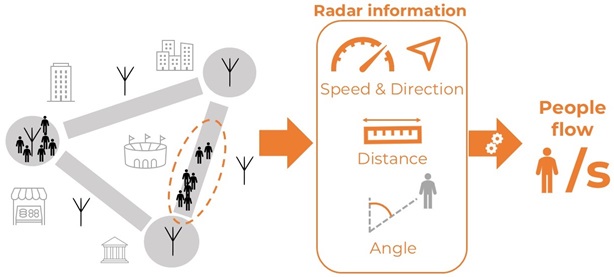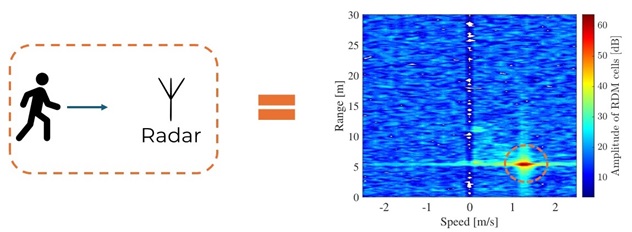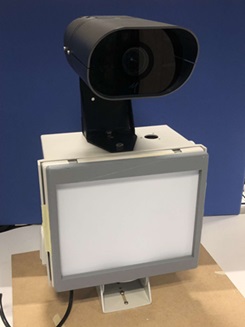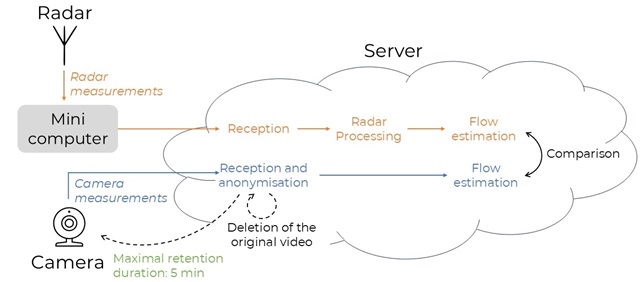In the same section
-
Share this page
People flow estimation with radars

Figure 1: Overview of the project
Problem statement
The CORFOU project aims to design a device for measuring anonymised flows of people to assess soft mobility in urban areas and manage security at events. It is based on radar technology: the radar is placed in a street and sends out a very low-power electromagnetic wave, up to 7 times weaker than a Wi-Fi box (EIRP radar = 14 mW), which bounces off groups of people. The radar measures the reflected wave and processes it to produce a “radar map”, in which each person appears as an amplitude peak, i.e. a red dot, as illustrated below.

Figure 2: Radar principle
Contribution
As the only information measured is the reflected wave, radar is totally anonymous by nature, with each person corresponding to a single point on the radar map. The radar map can then be processed by an algorithm to estimate the flow of people, i.e. their number, speed and direction. The research project aims to design the sensor, the appropriate radar signal processing and the flow estimation algorithm.

Figure 3: Measurement prototype
Measurement prototype
The measuring device, in the image above, is a box incorporating the radar and a miniature computer. For the prototyping and development phase, a camera is added above the sensor. It is used as a reference point for the design of the flow estimation algorithm: for each radar measurement, a video measurement is taken by the camera, for which algorithms for estimating the number of people, speed and direction already exist. In this way, the radar's estimation performance can be compared with the camera's. Each video is sent to an ISO27001-certified (information security management standard) processing and storage server. On arrival at the server, the video is anonymized by permanently and irreversibly blurring all characters, and the original video is destroyed on both the camera and the server. The maximum retention time of the original video on the camera is 5 minutes. The processing of the radar signal and camera image is detailed below.

Figure 4: Processing summary
Legal information - General Data Protection Regulation (GDPR)
This project has two parts :
- Crowd counting using radar
- Data validation via an image captured by a camera with a limited retention period.
Radars do not collect or process any personal data. As such, their installation and use do not fall within the scope of the General Data Protection Regulation. However, the cameras record images, which constitute personal data, solely for radar training purposes.
The Université libre de Bruxelles, Avenue Franklin Roosevelt 50, 1050 Brussels is the Data Controller for the data processed as part of this project.
The data is processed on the basis of the University's public interest mission in the field of scientific research.
The project managers have taken the necessary steps to protect the confidentiality and security of your data.
The images collected are strictly limited to what is necessary to train the radar and are not shared with anyone outside the research team.
The data is secured on the cameras (by the ULB network and by access control), when it is transferred to the server (by the Secure Shell protocol, SSH) and on the server itself (also by the ULB network and by access control). The physical security of the cameras is ensured by placing them high up. Disassembly requires special tools.
The maximum storage time is of 5 minutes on the cameras and, on the server, a maximum of 15 minutes of unencrypted storage while the images are blurred.
Questions relating to the protection of your personal data may be addressed to the ULB Data Protection Officer: Avenue F. Roosevelt 50, 1050 Brussels, CP 130, rgpd@ulb.be. This is also the address by which you can exercise your rights (access, rectification, erasure, objection and restriction of processing). If you feel that our response does not respect your rights, you may lodge a complaint with the Data Protection Authority (lodge a complaint | Data Protection Authority (autoriteprotectiondonnees.be).
Team participants
- Dr. Laurent Storrer
- Ir. Dejvi Cakoni
- Pr. François Horlin
- Pr. Philippe De Doncker
Research partners
► Macq Mobolity, Brussels, Belgium (Piotr Banach, Pr. Bruno Cornelis)
Research funding
► Innoviris : 2023-RDIR-41b - CORFOU: Conception d'un Radar de FOUle